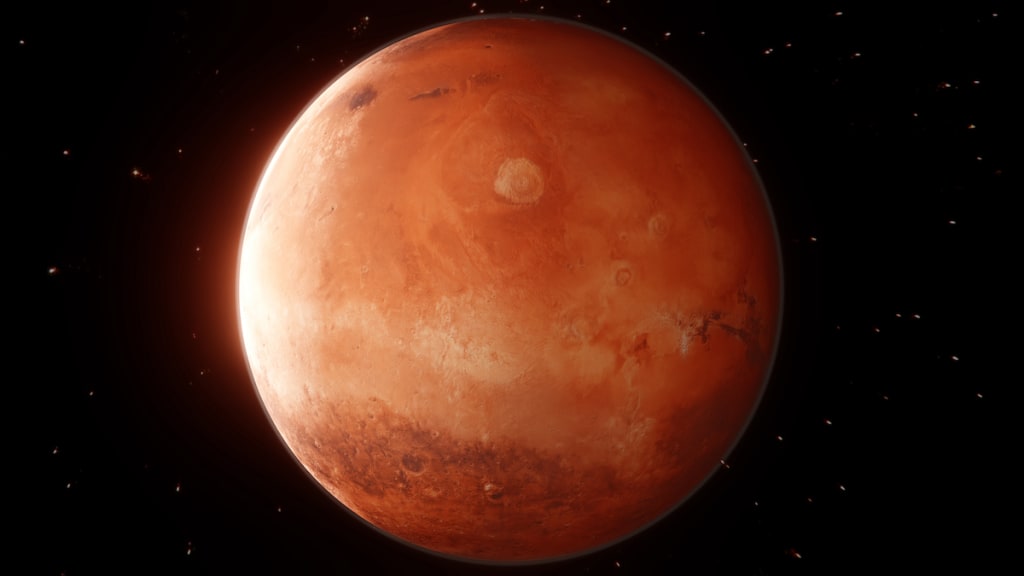MARS EXPLORATION NEWS: A MONTH OF DISCOVERY
Mars exploration was in the headlines for several reasons during the month of April. Find out the latest exploits of NASA’s Ingenuity, Curiosity and Insight rover missions on the Red Planet.

There’s something intriguing about Mars. From ancient times to our digital age, people seem to be captivated by the blood red world.
I remember figuring out how to aim my little backyard telescope at the rusty planet. The first thing that struck me was that it truly is a coppery red colour.
I could make out an ice cap, and some of the dark and light regions astronomers call albedo features. There wasn’t much detail visible to my untrained eye through amateur equipment, but there’s something sublime about seeing another world directly for ourselves.
MARS HAS INSPIRED ARTISTS, PHILOSOPHERS AND SCIENTISTS
I’m not alone in that sentiment. From antiquity, when our ancestors associated Mars with their war gods through the scientific discoveries of the enlightenment and the industrial age, Mars has inspired artists, philosophers and scientists.
Mars isn’t our closest neighbour. Technically, that’s Venus, although because of their varying elliptical orbits, it can be a bit of a toss-up.
The Red Planet draws our attention because it’s somewhat similar to Earth. There are some fundamental differences, but Mars is appealing because it resembles our planet’s geology, potential for liquid water atmosphere, although its air is awfully thin.
ROVERS REACH MILESTONES, SUPPORT KEY DISCOVERIES
Mars exploration has drawn even more attention than usual over the past month. The rovers NASA uses to study the Martian surface have reached important milestones, and researchers have made some key discoveries about the Fourth Planet’s internal structure.
The plucky little unmanned aerial vehicle (UAV) Ingenuity flew its 50th mission on April 13. It travelled 322 metres in 146 seconds. It also reached a new hight of 18 metres before touching down in the Belva Crater.
Ingenuity was supposed to be demonstration vehicle. The plan was to fly it a maximum of five times to see if a powered, controlled-flight helicopter was feasible in the Martian atmosphere.
“WE WOULD BE INCREDIBLY LUCKY TO EKE OUT FIVE FLIGHTS”
“When we first flew, we thought we would be incredibly lucky to eke out five flights,” according to Teddy Tzanetos, Ingenuity’s team lead at NASA’s Jet Propulsion Laboratory. “We have exceeded our expected cumulative flight time since our technology demonstration wrapped by 1,250% and expected distance flown by 2,214%.”
Ingenuity is starting to wear out, though, and its days are numbered. “Whether Ingenuity’s mission ends tomorrow, next week, or months from now is something no one can predict at present,” Mr. Tzanetos explained. “What I can predict is that when it does, we’ll have one heck of a party.”
Meanwhile, NASA’s Curiosity Mars Rover had a major software upgrade last month. This is its first software refresh in seven years.
CURIOSITY CAN BETTER WATCH WHERE ITS GOING
The application upgrade includes more than 180 enhancements that enable it to better watch where its going, steer better, drive faster, reduce wheel wear and send more accurate messages. It also integrates a bunch of earlier software patches, simplifying the code.
Curiosity has conducting Mars exploration for over a decade now, so it’s also showing its age. Even so, as Jonathan Denison, Curiosity’s engineering operations team chief, put it, “Even though we’re almost 11 years old, we’re still implementing new ideas to use more of our available energy for science activities.”
Speaking of aging, NASA’s InSight Mars lander shut down back in December, but its seismic data enabled scientists to make their first ever direct observations of another planet’s core.
LEADING SEISMOLOGIST JOINED NASA’S INSIGHT TEAM
Professor Jessica Irving is an Earth scientist at the University of Bristol who’s been studying the seismology of Earth’s inner core for for the past ten years. Lately, she’s also joined NASA’s InSight science team, helping with Mars exploration by applying geological principles.
Last month, the Proceedings of the National Academy of Science published a paper by Professor Irving and her team outlining their discoveries about the Martian core.
Insight captured two earthquakes back in 2021. Luckily, they were “far side quakes,” meaning they were on the other side of Mars from the Insight lander.
“WE NEEDED BOTH LUCK AND SKILL”
Being so far away, their seismic waves could travel much deeper into the planet before InSight detected them. “We needed both luck and skill to find, and then use, these quakes,” Professor Irving explained. “Far side quakes are intrinsically harder to detect because a great deal of energy is lost or diverted away as seismic waves travel through the planet.”
Detecting these far side quakes enabled the researchers to determine that Mars’ liquid iron core has a smaller volume and greater density than previously thought. Analyzing the data led the team to conclude that 22% of the Red Planet’s core consists of sulphur, oxygen, carbon, and hydrogen.
Study co-author Doyeon Kin of ETH Zurich added, “Determining the amount of these elements in a planetary core is important for understanding the conditions in our solar system when planets were forming and how these conditions affected the planets that formed.”
FINDINGS HELP SCIENTIST UNDERSTAND EARLY SOLAR SYSTEM
These more accurate findings about Mars’s inner composition will help scientists understand what our solar system was like in its early stages. That knowledge will shed light on the conditions that might lead to planet formation around other stars.
I find it interesting how we empathize with our robotic devices toiling away on Mars exploration. We all love a hero’s journey, and these tenacious devices seem to captivate us with their field work.
AND ANOTHER THING…
Although they’re not self-aware, in a sense our Mars exploration rovers are making scientific discoveries on our behalf. They’re part of the new story humanity is unwinding about our planet, the universe and our place within it all.
The researchers plan to continue Mars exploration, delving further into the planet’s core. As they say in their paper, “Future geophysical missions to Mars will be vital to refining models of the Martian core beyond these first seismological estimates…Meanwhile, continued analysis of the InSight seismic data will prove helpful in further refining models of Mars’ interior structure.”
We always have more to learn if we dare to know.
Learn more:
NASA’s Ingenuity Mars Helicopter Completes 50th Flight
NASA’s Curiosity Mars Rover Gets a Major Software Upgrade
NASA InSight Study Provides Clearest Look Ever at Martian Core
First observations of core-transiting seismic phases on Mars
Water on Mars: Where Does It All Go?
About the Creator
David Morton Rintoul
I'm a freelance writer and commercial blogger, offering stories for those who find meaning in stories about our Universe, Nature and Humanity. We always have more to learn if we Dare to Know.






Comments
There are no comments for this story
Be the first to respond and start the conversation.